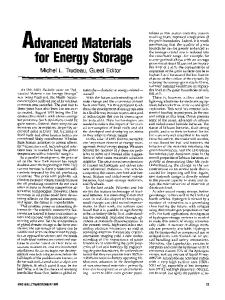Quinone-Decorated Carbon Materials for Capacitive Energy Storage Applications
- PDF / 46,472,702 Bytes
- 8 Pages / 612 x 792 pts (letter) Page_size
- 50 Downloads / 357 Views
Quinone-Decorated Carbon Materials for Capacitive Energy Storage Applications Mikolaj Meller, Krzysztof Fic and Elzbieta Frackowiak Poznan University of Technology, Institute of Chemistry and Technical Electrochemistry, Poznan, Poland ABSTRACT Quinone/hydroquinone redox couple has been utilized as a source of additional capacitance in typical capacitive energy-storage materials. By generation of functional groups on the carbon electrode surface (grafting) directly from electrolyte there is a possibility to enhance the capacitance value significantly. Hydroxybenzene solutions with different substitution of hydroxyl groups were effectively used for this target. Electrochemical and physicochemical properties of activated carbons have been investigated before and after grafting process. INTRODUCTION Electrochemical capacitors became one of the most developed power sources. Contrary to conventional batteries, such as lithium-ion or nickel-metal hydrides, they can release extremely huge peak of power. Hence, they are able to be charged and discharged in a very short time due to electrostatic mechanism of charge accumulation. Unfortunately, at the same time their energy is incomparably lower than in case of batteries. One can notice, that to face the main requirements of portable devices market, the energy of electrochemical capacitors needs to be significantly higher. Improvement of this parameter could make them much more attractive for mobile applications, like phones, laptops, tablets or digital cameras. According to the following formula
1 E = ⋅ C ⋅U 2 , 2 where E represents energy, C is cell capacitance and U means operational voltage, it is easy to observe that the energy can be increased by two different ways [1]. First of all, energy enhancement can be done by operational voltage widening, for example by using organic electrolytes that are able to operate at much higher voltages than aqueous electrolytes. Acetonitrile-based electrolytes can reach even 2.7V without any decomposition. Another method for energy increase is by providing additional charge to the total capacitance value. Therefore, besides typical electrostatic attraction of ions and their accumulation in porous structure, there is also a contribution of reversible redox reactions, so called pseudocapacitance [2]. Such combination of two different mechanisms of charge storage allows to increase capacitance value significantly. A lot of papers are focused on different electrode materials that can exchange electrons during charging/discharging processes, such as transition metal oxides or conducting polymers [3-5]. Unfortunately, there are few drawbacks that cannot be avoided when those materials are used, i.e. high price or diffusion limitations. That is the reason why electrolytes that reveal redox activity seem to be very good alternatives. It was already shown that it is possible to get satisfying results by applying electrolytes such as potassium or sodium iodides [6], [7] or redox couple consisting potassium iodide and vanadyl sulfate [8].
In thi











